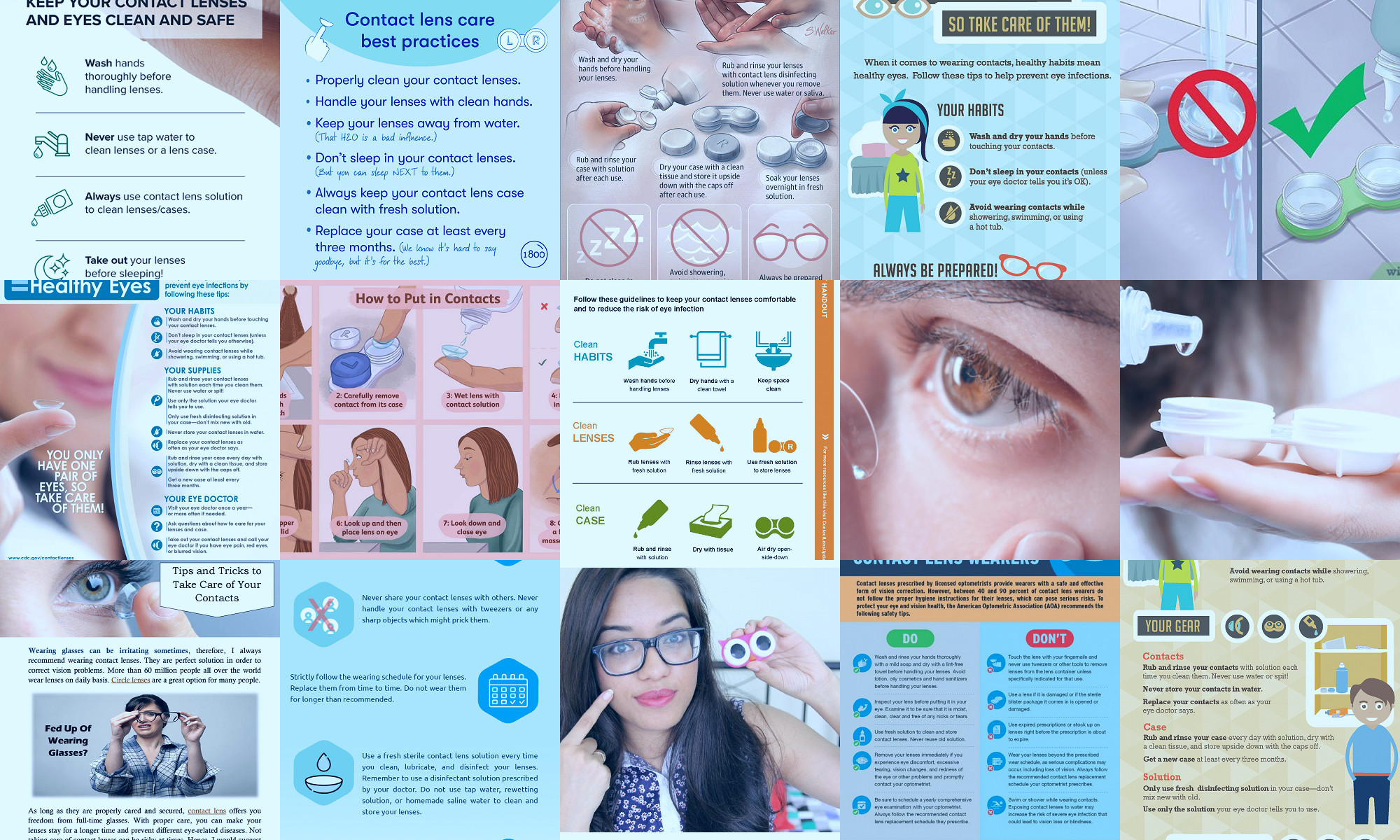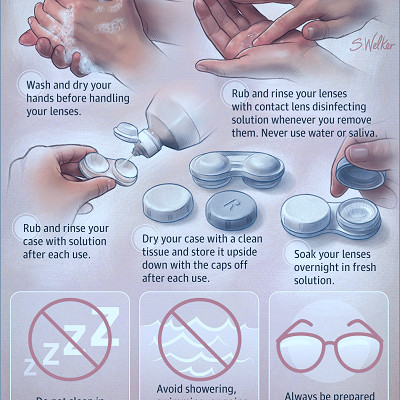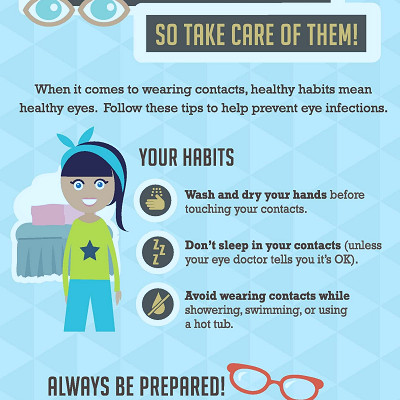 Jarlat Maletych/Shutterstock
Jarlat Maletych/Shutterstock
Features
Understanding Contact Lenses
Contact lenses are thin, curved lenses placed on the surface of the eye to correct vision problems. They provide an alternative to glasses and can significantly improve quality of life for individuals with visual impairments. However, they require proper care and handling to maintain their effectiveness and prevent eye infections.
Importance of Hygiene
Always wash and dry your hands before handling your contact lenses. This reduces the risk of introducing harmful bacteria to your eyes. Never use tap water or saliva to clean your lenses as they can contain microorganisms that can cause serious eye infections.
Proper Cleaning of Lenses
Use a multi-purpose contact lens solution to clean, rinse, and disinfect your lenses. Never reuse old solution. Following the instructions on the solution bottle will ensure your lenses stay clean and safe for use.
Storing Contact Lenses
Always store your lenses in a contact lens case filled with fresh solution. This helps to keep them moist and clean. Replace your contact lens case every three months to prevent bacterial growth.
Regular Replacement of Lenses
Adhere strictly to the replacement schedule recommended by your optometrist. Over-wearing lenses can lead to discomfort, poor vision, and eye infections.
Limiting Wear Time
Avoid wearing your contact lenses for more than 19 hours a day. This gives your eyes a chance to breathe and reduces the risk of eye irritation.
Avoiding Dryness
If your eyes feel dry, use a lubricating eye drop approved for use with contact lenses. This can help restore moisture and comfort.
Sleeping in Contact Lenses
Unless prescribed by your optometrist, avoid sleeping in your contact lenses. This can deprive your cornea of oxygen and lead to serious eye problems.
Handling Contact Lenses
Always handle your lenses with your fingertips. Avoid using sharp objects like tweezers that can damage the lenses.
Wearing Makeup with Contact Lenses
Always put your contact lenses in before applying makeup. This prevents makeup particles from getting trapped under your lenses.
Visiting the Optometrist
Regular check-ups with your optometrist are crucial. They can assess the health of your eyes and the fit of your contact lenses.
Handling Sore Eyes
If your eyes become red, irritated, or painful, remove your contact lenses immediately. If the discomfort persists, seek medical attention.
Maintaining a Backup Pair of Glasses
It's wise to have a pair of glasses as a backup. You may need to give your eyes a break from contact lenses, especially if you're experiencing discomfort or an eye infection.
Exercise Caution in Water
Avoid wearing contact lenses in swimming pools, hot tubs, or while showering. Water can harbor harmful bacteria and increase the risk of eye infections.
Using Therapeutic Lenses
For those with dry eyes or allergies, therapeutic contact lenses can help. These lenses are designed to hold moisture and can provide relief from dryness and irritation.
UV Protection
Some contact lenses offer UV protection. However, they should not replace sunglasses, which provide a broader range of UV protection for the entire eye area.
Dealing with Allergies
If you have allergies, use daily disposable contact lenses. This reduces the chance of allergen build-up on the lens surface.
Adapting to Contact Lenses
It may take some time for your eyes to adapt to wearing contact lenses. Start by wearing them for a few hours a day, gradually increasing the duration.
Contact Lens Safety
Never share your contact lenses with others. This can spread harmful bacteria and potentially lead to eye infections.
Healthy Diet
A diet rich in vitamins A, C, and E, as well as Omega-3 fatty acids, can help maintain eye health. This is particularly important for contact lens wearers, as it can help prevent dry eyes and other related issues.
Interesting notes and facts
1. The Importance of Hand Hygiene: One of the cardinal rules in wearing contact lenses is to always wash your hands before touching them. Oils, lotions, and germs from your hands can get transferred to your lenses, potentially causing eye infections. Using a mild, non-perfumed soap is recommended. After washing, dry your hands with a lint-free towel to avoid getting any fluff on your lenses.2. Proper Lens Cleaning: Cleaning your contact lenses regularly is vital for maintaining good eye health. Use only the lens solution recommended by your optometrist, not water or saliva. Rub and rinse your lenses gently with the solution to remove any dirt or deposits. Remember, cleaning is a two-step process – disinfecting alone is not enough.
3. Storage Matters: When not in use, store your contacts in a clean lens case filled with fresh solution. Old solution or water can harbor bacteria and other microorganisms. Additionally, replace your contact lens case every three months to prevent bacterial growth.
4. Stick to the Schedule: Wearing your contact lenses longer than recommended can cause serious eye problems. It's important to follow the wear schedule prescribed by your eye care professional, whether they're daily, weekly, or monthly lenses. If your lenses are uncomfortable or cause redness, remove them immediately and consult your optometrist.
5. Avoid Sleeping in Your Contacts: Unless your lenses are specifically designed for extended wear, avoid sleeping with them in. Doing so increases the risk of corneal infections, ulcers, and even vision loss. Your eyes need to breathe, and leaving your contacts in overnight can deprive them of oxygen.
6. Don’t Swim With Contacts: Contact lenses should not be exposed to any kind of water, including lakes, oceans, swimming pools, or hot tubs. Water can cause lenses to change shape, swell, and stick to the eye, leading to significant discomfort and possible eye infections.
7. Regular Eye Check-ups: Regular visits to your optometrist are crucial when you're wearing contact lenses. These appointments allow your eye doctor to monitor your eye health and ensure your contacts are still suitable for your eyes. If you notice any changes in your vision or eye comfort, schedule an appointment right away.
8. Proper Insertion and Removal: Always insert your lenses before applying makeup and remove them before washing your face or removing makeup. This helps prevent makeup particles from getting on the lenses and irritating your eyes.
9. Always Have a Backup: It's a good idea to have a pair of up-to-date glasses in case you need to stop wearing your contacts temporarily. This could be due to an eye infection, irritation, or simply giving your eyes a break.
10. Hydrate Your Eyes: Wearing contact lenses can sometimes dry out your eyes. Use rewetting drops approved by your optometrist to keep your eyes hydrated. Avoid over-the-counter eye drops that aren’t designed for contact lens wearers.
Vocabulary
- Contact Lenses – Thin lenses placed directly on the surface of the eye to correct vision.
- Optometrist – A healthcare professional who provides primary vision care.
- Saline Solution – A sterile solution of salt in water, used in the care of contact lenses.
- Solution Case – A small container for storing contact lenses in disinfecting solution when not in use.
- Daily Wear Contacts – Contact lenses that are taken out each night and cleaned.
- Extended Wear Contacts – Contact lenses that can be worn overnight, up to seven days without removal.
- Disinfecting Solution – A solution used to kill bacteria and other micro-organisms on contact lenses.
- Protein Remover – A product used to clean protein deposits off contact lenses.
- Soft Contacts – Contact lenses made of soft, flexible plastics that allow oxygen to pass through to the cornea.
- Rigid Gas-Permeable (RGP) Contacts – Contact lenses made of durable plastic that transmits oxygen.
- Astigmatism – A common vision condition that causes blurred vision.
- Bifocal Lenses – Lenses with two distinct optical powers, used mostly by people over 45 who cannot focus well on close objects.
- Toric Lenses – Contact lenses designed to correct astigmatism.
- Hygiene – Practices that help to maintain health and prevent diseases.
- Vision Correction – The use of corrective lenses to improve visual acuity.
- Cornea – The clear, dome-shaped surface that covers the front of the eye.
- Presbyopia – A condition that results in difficulty in reading or seeing at close distances.
- Disposable Contacts – Contact lenses that are discarded after a single use.
- Monovision – A method of correcting presbyopia by wearing one contact lens to correct distance vision, and another to correct near vision.
- Ophthalmologist – A medical doctor who specializes in eye and vision care.
- Sclera – The white part of the eye.
- Conjunctiva – The thin, clear tissue that covers the white part of the eye and the inside of the eyelids.
- Keratitis – Inflammation of the cornea.
- Dry Eyes – A condition characterized by insufficient tear production.
- Tears – A clear liquid that the eyes produce to lubricate and protect themselves.
- Allergies – An immune system reaction to a substance that is not normally harmful.
- Eye Infections – Infections that occur in the eye, commonly caused by bacteria, viruses or fungi.
- Silicone Hydrogel Lenses – A type of soft contact lens material that allows more oxygen to pass through the lens to the cornea than regular soft lens material.
- Multifocal Lenses – Contact lenses with different powers in different zones of the lens to correct presbyopia.
- Myopia – Nearsightedness, a condition where distant objects appear blurry.
- Hyperopia – Farsightedness, a condition where close objects appear blurry.
- Lens Fitting – The process of determining the correct lens specifications for a patient.
- Lens Care – The process of cleaning, rinsing, and disinfecting contact lenses.
- Eye Drops – Drops used to lubricate, hydrate, or medicate the eyes.
- UV Protection – Blocking or absorbing ultraviolet (UV) light using lenses.
- Lens Case – A case used to hold, clean, and disinfect lenses.
- Hand Washing – The act of cleaning hands with soap and water to remove germs and dirt.
- Contact Lens Insertion – The process of placing a contact lens on the eye.
- Contact Lens Removal – The process of taking a contact lens out of the eye.
- Optician – A professional who fits and sells eyeglasses and contact lenses.
- Lens Prescription – The written specification for an ophthalmic lens that an optometrist or ophthalmologist provides.
- Visual Acuity – The clarity or sharpness of vision.
- Eye Examination – An assessment of the visual system performed by an eye care professional.
- Daily Disposable Lenses – Contact lenses that are thrown away at the end of each day.
- Lens Comfort – The degree to which a contact lens can be worn without causing discomfort.
- Dry Eye Syndrome – A chronic condition characterized by insufficient tear production.
- Contact Lens Solution – A liquid used for cleaning, rinsing, disinfecting, and storing contact lenses.
- Eye Irritation – Discomfort or annoyance in the eye, often caused by foreign objects or harsh conditions.
- Oxygen Permeability – The ability of a material (like a contact lens) to allow oxygen to pass through it.
- Lens Coating – A thin layer applied to the surface of a lens to reduce reflections and glare.



